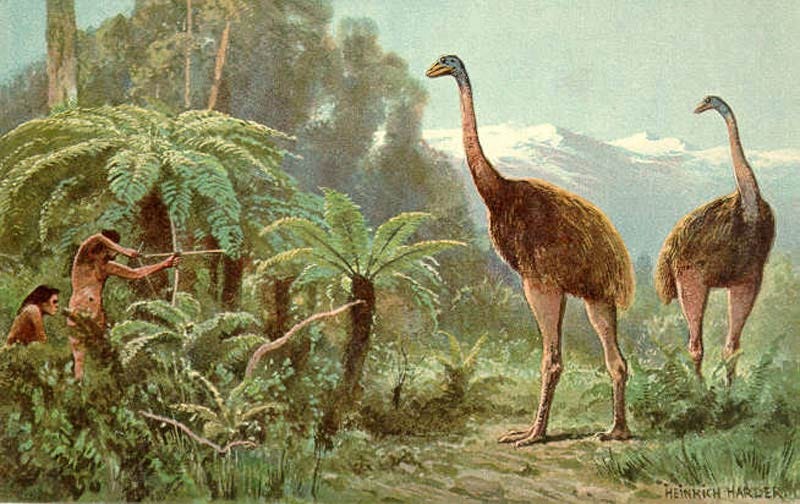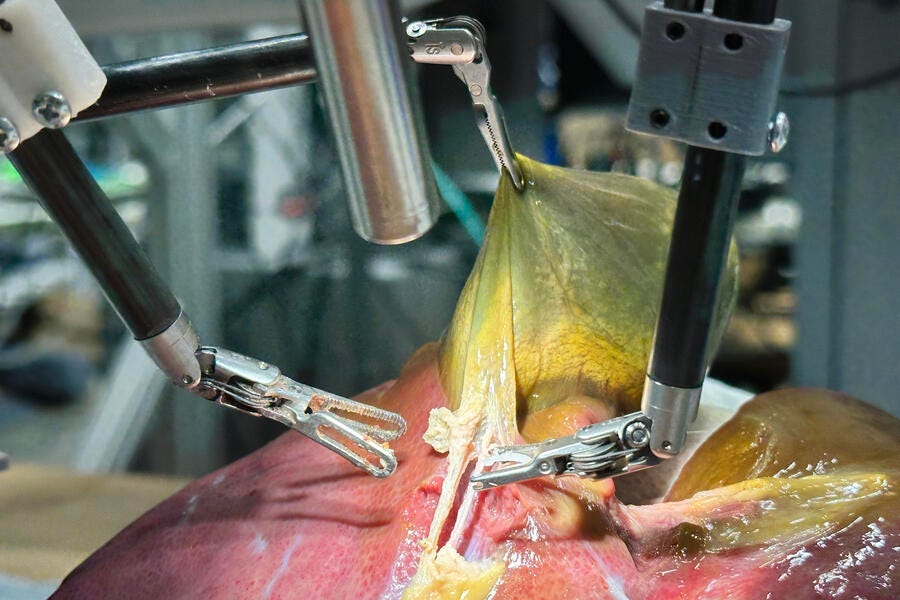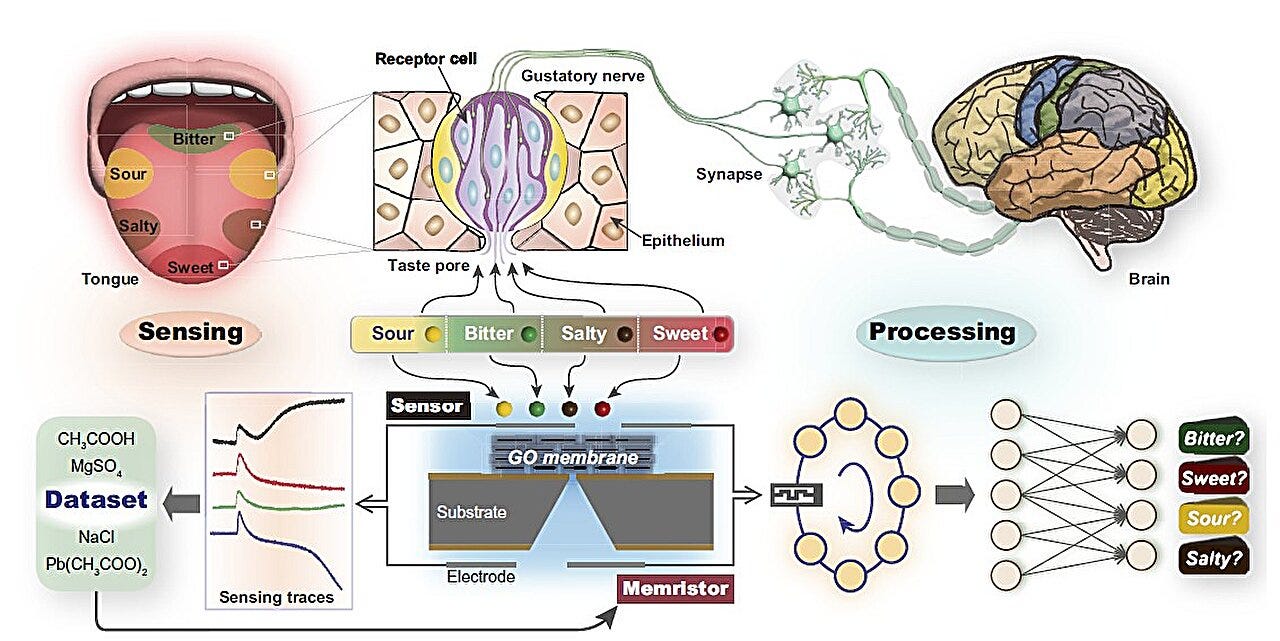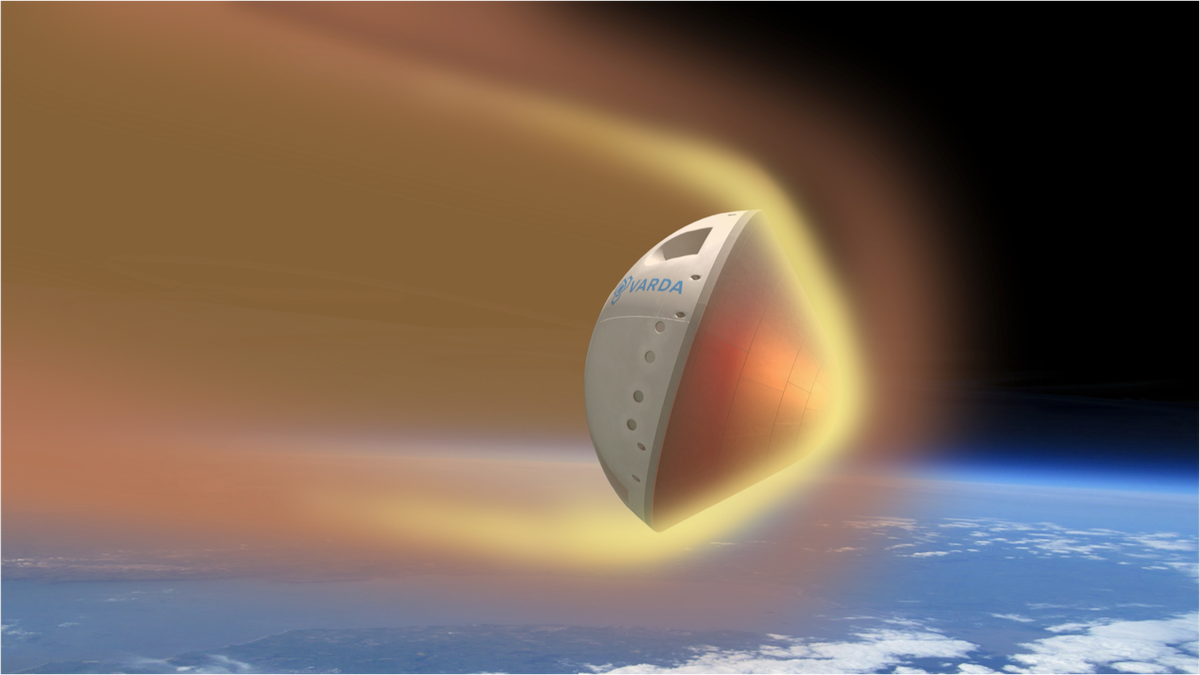Weekly Dose of Optimism #152
Rainmaker, Moas, Robotic Surgeons, AI Taste, Nvidia, Everyday Wealth, Varda
Hi friends 👋 ,
Happy Friday and welcome back to our 152nd Weekly Dose of Optimism. They said that nothing happens in July. That the VCs and founders and changemakers are all galavanting across Europe, humble-complaining about the lack of air conditioning, and observing that they actually lost weight while in Italy despite eating pasta every day and not working out. Well they were wrong. It was an action packed week. The world marches onward, even in July.
Let’s get to it.
Today’s Weekly Dose is brought to you by … HoneyBook
Running your own client-based business can be awesome. Your schedule. Your terms. No boss.
But it also means no support. You have to manage contracts, send invoices, collect payments, and schedule meetings all by yourself. That’s not what you’re best at, and not why you went independent. So for the past 12 years, HoneyBook has given independent entrepreneurs the tools they need to make all of the less fun parts easier.
Now, HoneyBook is starting to just handle all of that for you. By sprinkling AI onto a product that already understands your workflows, HoneyBook can automate more and more of the stuff that you don’t want to do so you can focus on the things that make you great.
This is literally the promise of AI. Freeing humans from drudgery to focus on creative pursuits.
Free yourself. Check out HoneyBook’s AI-powered platform today.
(1) They Want Him Dead. Augustus Doricko Just Wants to Make It Rain.
Blake Dodge for Pirate Wires
In short, the flooding wasn’t their fault.
But the virality of the blame, and the intensity of the emotion behind it, is officially a Rainmaker trend. It could master the intricacies of cloud physics just to be taken out of the game by people who believe that Jewish space lasers are responsible for wildfires — or that the white trails behind airplanes are actually government mind-control chemicals (chemtrails). RFK Jr. followers, thanks to his public endorsements of the chemtrail theory, are violently opposed to Rainmaker, because they think cloud seeding is not worth distinguishing from chemtrails. Thanks to pressure from this community, and perhaps general willingness on the part of politicians to farm engagement from anti-establishment audiences, 31 states introduced bans against cloud seeding and other forms of weather modification in the last year.
Packy here. Over 4th of July Weekend, a slow‑moving mesoscale convective vortex—fed by remnants of Tropical Storm Barry—dropped up to 20 inches of rain, or between 5.5 and 5.8 million acre-feet, in Central Texas’ Hill Country. Over 120 people died in the floods, including many children from Camp Mystic, and over 170 people remain missing.
The floods and the loss of life they caused were a tragedy. I drop my son off at the camp bus stop every morning. I can’t imagine what those parents are going through.
But they weren’t Rainmaker’s fault, as Pirate Wires’ Blake Dodge writes in this epic profile:
In Texas, Rainmaker suspended operations, following guidance from in-house meteorologists, a day before Texas officials would have required them to; the last two clouds it seeded dissipated more than 24 hours before the storm’s arrival; and, for context, even the startup’s most successful missions have only produced about 0.0005% of the rain that the storm did in a 48-hour period.
Despite that, over the past week, Rainmaker CEO Augustus Doricko has taken on an onslaught of conspiracy theorists, politicians, trolls, and concerned citizens who blame his company for the disaster to win political points, or just because they need someone to blame, and the mulletted 25-year-old CEO of a tech company is an easy target. He’s handled it with facts and grace.
If we can harness technology to make it rain, or even to avoid disasters like the one that befell Texas, we must. Critics claim companies like Rainmaker are playing God, but the fact is, the natural state of planet earth is hostile to humans.
In The Beginning of Infinity, something of a Weekly Dose Bible, David Deutsch explains:
The Earth was not a suitable environment for humans until they changed it. The first humans to leave Africa had to invent clothes, shelters, and new hunting techniques to survive in colder climates. Every step in human progress has involved transforming the environment to suit our needs, using knowledge.
Lives are lost every day from lack of adequate water, as are livelihoods. In the profile, Dodge shares that in Utah, one of Rainmaker’s first customers, “The depletion [in lake levels] is harming surrounding ecology and exposing toxic, arsenic-containing dust from the lakebed, which blows into the city and appears to be worsening respiratory health.” If Utah works, Dodge writes, Rainmaker has a case to replenish the Colorado River. “The river provides drinking water for 35 to 40 million people across seven states, irrigates millions of acres of crops, and produces billions of kilowatt-hours of hydroelectricity — so its decades-long drought is an issue.”
Earth can be a dangerous place for living creatures, like us. Rainmaker is fighting back on our behalf with knowledge. “There’s a lot about the weather we don’t understand. We are making it rain more. Can we make it rain less?”, Dodge asks.
The company may succeed, or it may fail, but we certainly can’t let it stop trying because of some conspiracy-toting fear-mongerers. One of the reasons we started writing the Weekly Dose is that we want to support the people who try despite the long odds. Rainmaker is full of those people.
Make it rain, Augustus.
(2) Oscar‑Winning Movie Director Is Betting $15M on a Bird That Went Extinct 600 Years Ago
Maggie Ekberg for Complex
The 63-year-old Oscar-winning filmmaker has officially joined forces with Colossal Biosciences to help bring a long-extinct bird back from the dead. On Tuesday, July 8, the biotech company announced it’s partnering with Jackson and New Zealand’s Ngāi Tahu Research Centre to resurrect the moa — a massive, flightless bird that went extinct around 600 years ago. Jackson is backing the project with a reported $15 million in funding.
Back to Dan. In a move as epic as his films, Peter Jackson is teaming up with Colossal Biosciences (a company we’ve covered multiple times in the Weekly Dose) to bring back the moa, a giant (we’re talking 12 feet tall here fellas!) bird that went extinct over 600 years ago. The project is a combination of Jackson’s purported obsession with moas (you didn’t expect the Lord of the Rings guy to be normal, right?) and Colossal’s scientific and commercial ambition to de-extinct cool, big animals.
The project is notable for a few reasons:
You love to see a rich guy dedicating some of his wealth to pursuing far-flung scientific endeavors. When tech billionaires do it, they somehow get flack. But when the Lord of the Rings director does it, it’s pretty cool. Modern Magnificenza!
Another win for Colossal. The company has been on a tear: high valuations, creating woolly mice, and generally progressing on de-extinction efforts more than most naysayers projected. The collab with Jackson is certainly interesting…imagine a Jurassic Park type world created by Jackson filled with creatures de-extincted by Colossal. (Packy note: they also just showed up on The Secret of Skinwalker Ranch, analyzing what might be a real direwolf jawbone for the guys.)
Moas are pretty cool. Tall as shit. Flightless. I basically just picture Larry Bird from the neck up on the body of an ostrich. Is Jackson’s obsession with them a little weird? Sure. But if Jackson wants to front the bill on bringing these big ass birds back to life, I, for one, am not going to stop him.
(3) Robot performs first realistic surgery without human help
Jill Rosen for The Hub at Johns Hopkins University
A robot trained on videos of surgeries performed a lengthy phase of a gallbladder removal without human help. The robot operated for the first time on a lifelike patient, and during the operation, responded to and learned from voice commands from the team—like a novice surgeon working with a mentor.
A robot from Johns Hopkins, trained on videos and voice commands, autonomously performed a complex phase of gallbladder removal surgery on a lifelike model. Unlike earlier systems that followed rigid plans, this new robot, SRT-H, adapted in real time to unpredictable scenarios, responded to spoken feedback, and made surgical decisions on the fly. This wasn’t a robot executing against a pre-ordained set of instructions, this was a robot performing dynamic and real-time surgery.
We’re still a ways off from a surgery like this being performed on live humans or from scaling this up to multiple types of surgeries and hundreds of thousands of patients. And personally, I will take a real life surgeon cutting me open and fixing my organs over an autonomous robot at this point. But this is a big step towards bringing AI surgeons into the operating room. Surgeons already rely heavily on technology and machinery and robotic assistance in performing surgery, but getting autonomous robots in the operating room could dramatically improve the safety of surgeries and reduce the cost of healthcare.
(4) Sweet or sour? AI-powered device achieves human-like sense of taste
Katie Kavanagh for Nature
A device that combines a graphene-derived material with machine learning to detect salty, bitter, sweet and sour flavours could one day help to restore a lost sense of taste to people with neurological conditions.
Yum!
Researchers have built a graphene-oxide “tongue” that uses AI to detect salty, sweet, sour, and bitter flavors with up to 90% accuracy, even in wet, mouth-like environments. Unlike earlier sensors, it mimics how our tongues send electrical signals to the brain, and it can even identify complex flavors like coffee and cola. Whether it can tell Diet Coke from Diet Pepsi remains to be seen, but that might be the real Turing test.
Like other brain-computer interface tech, this is starting with people who need it most. Neuralink is targeting paralysis and ALS; this taste tech could help patients with Parkinson’s, MS, or stroke regain a lost sense of taste. But the implications go far beyond medicine. If we can digitize senses like taste, smell, and vision, we’re laying the groundwork for a sort of sensory internet. Imagine scrolling through DoorDash and getting little tastes of the food before you order it or thinking back to your grandma’s kitchen and getting a real whiff of her home cooking or feeling the touch of a long distance loved one. Both spooky and cool.
(5) Nvidia's stock market value hits $4 trillion on AI dominance
Shashwat Chauhan for Reuters
Nvidia briefly reached a market capitalization of $4 trillion on Wednesday, making it the first company in the world to reach the milestone and solidifying its position as one of Wall Street's most-favored stocks.
Earlier this week, Nvidia briefly became the first company ever to surpass a $4 trillion market cap. The company’s financials are insane, demand for its products is insatiable, and its stock performance is bolstered by really every tailwind imaginable. The company is on a decades-long heater at this point, rising from a $5B market cap in 2009 to a $4T market cap today. That’s a 790x in 16 years off an an already relatively high $5B market cap. Insane.
And for good reason: Jensen was prescient (or very very lucky) with his early bet on GPUs. But the company has also been (at risk of stating the obvious) extremely strategic in transitioning from being merely a chip designer to building the full-stack AI platform. If you believe that AI is going to be very big and important and valuable, at this point you also have to believe that Nvidia is going to capture a lot of that value.
The Nvidia story aligns perfectly with one of Not Boring’s core theses over the last coupe of years: Tech is Going to Get Much Bigger. The core idea is that tech is entering a new era defined by the convergence of software, hardware, and AI which will unlock intelligence, energy, and dexterity at near-zero marginal cost. This shift dramatically expands tech’s addressable market, making room for much larger companies than we’ve seen before. Nvidia, its chips and its full-stack AI platform, is perhaps the company which makes this entire thesis possible. If you think tech, broadly speaking, is going to get much bigger, you think Nvidia is going to get much, much bigger. And ultimately the real winners here, beyond the Nvidia shareholders and employees (congrats!), are the companies and consumers whose lives are going to get a lot better and longer thanks to the technology enabled by Nvidia.
(Not Financial Advice, of course. No one has ever made money investing in a $4 trillion company.)
(Bonus) The Wealth of Everyday
Clifford Sosin on X
Tomorrow, when I rise again on that utterly ordinary mattress, I’ll whisper a thank-you to the engineers, farmers, nurses, coders, and soldiers who turned luxury into baseline. God bless the United States of Standard-Issue Comfort—and the patriotic genius that made equality feel so wonderfully mundane.
Cliff Sosin, an investor recently notable for his appearance on Invest Like the Best, shared a lovely reflection on the everyday wealth that Americans enjoy today. Yes, tech has gotten bigger, and the rich have gotten richer, but during this same wave the quality of life for almost all Americans has also risen dramatically. And that quality of life is driven, in large part, by the everyday niceties that almost everybody has access to: comfortable mattresses, effective personal care items, affordable electronics, accessible utilities, free information, quick shipping, convenient food options, etc, etc.
This piece really resonated with me. I am a relatively simple man: I’d rather spend my money on things like Starbucks coffee, an apartment with a bath tub (yes, I take baths!), some quality athleisure clothing and high quality groceries than expensive watches, fancy trips, or exclusive memberships. Nice things are certainly nice, but 99% of my mood and general happiness is driven by day-to-day convenience and comfort. And I’d imagine, if you polled the richest people in the world, behind the yachts and private jets and members-only clubs, that they’d tend to agree.
The funny thing is that we, the 99.9% of people need those richest people, with their yachts and PJs and extraordinary bank accounts, in order for us to enjoy the everyday wealth that we’ve become accustomed to. If Jeff Bezos couldn’t easily afford a $50 million wedding, I wouldn’t have free, next day shipping. If Nivida shareholders didn’t enjoy 790x returns, I wouldn’t be able to one day receive a safe and affordable AI robotic surgery. If Sergei Brin didn’t have a mega yacht, I’d have way less access to free information and knowledge. Simply put, we need more billionaires if we all want to live lives that are, for the most part, indistinguishable from the lives of billionaires.
(Double Bonus) Varda Announces $187 million in Series C Funding to Make Medicines in Space
Varda Space Industries announced a Series C fundraising round today, bringing the total amount of capital raised by the microgravity-enabled life sciences company to $329 million. The $187 million fundraise was led by Natural Capital and Shrug Capital, with participation from Founders Fund, Peter Thiel, Khosla Ventures, Caffeinated Capital, Lux Capital, and Also Capital.
Congratulations to Not Boring Capital portfolio company Varda Space on their $187M Series C. Varda is one of the companies we’ve written about most at Not Boring, and for good reason: its mission is ambitious and hard, it’s vertically integrated, and its story is great. The company manufactures pharmaceuticals and advanced materials in microgravity using orbital labs, while also providing hypersonic reentry testing for government partners, all to build the foundation of a scalable economy beyond earth. Varda sounds like sci-fi, but it’s executing like sci-non-fi. And now it has some fresh Earth dollars to fuel its out-of-this-world ambitions.
Have a great weekend y’all.
Thanks to HoneyBook for sponsoring. We’ll be back in your inbox next week.
Thanks for reading,
Packy + Dan











My great-nephew graduated from Medical School in May, and there were two da Vinci Surgical Systems. An anesthesiologist friend said there are the same systems in the hospital at which his group practices:
https://en.wikipedia.org/wiki/Da_Vinci_Surgical_System
No doubt you know radial keratotomy is computerized. Liquid Valium stabilizes the eye, the computerized robot performs the procedure.